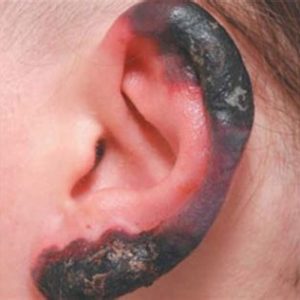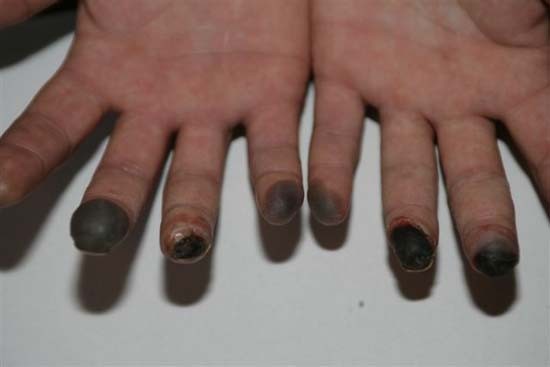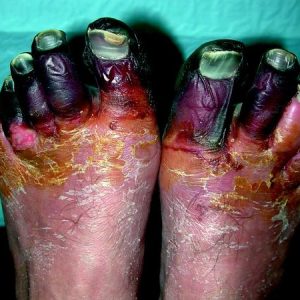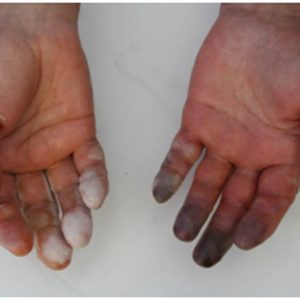Survival Skills: How to Treat Frostbite
 Survival Skills: How to Treat Frostbite
thegearhunt.com
Survival Skills: How to Treat Frostbite
thegearhunt.com
Frostbite happens when the tissues in your body freeze. This is a condition that occurs when you have been exposed to temperatures that are below your skin’s freezing point. If you develop a body temperature that is abnormally low, that is called hypothermia. Hypothermia and frostbite are both medical emergencies that are related to the cold.
 Frostbite is a condition that has been recognized for many hundreds of years. In fact, a pre-Columbian mummy that is thought to be 5,000 years old was discovered in the mountains of Chile. This mummy represents the earliest evidence of frostbite that is documented.
Frostbite is a condition that has been recognized for many hundreds of years. In fact, a pre-Columbian mummy that is thought to be 5,000 years old was discovered in the mountains of Chile. This mummy represents the earliest evidence of frostbite that is documented.
The Surgeon General for Napoleon, a man named Baron Dominique Larrey, is responsible for providing the first-ever description of how frostbite works. That was back in 1812, when his army was retreating from Moscow. He also took note of the cycle of freeze-thaw freeze that is harmful. This would happen when soldiers would warm their frozen feet and hands over fires at night only to have them freeze again during the next day.
Frostbite used to be a problem primarily for the military and the homeless. Now, it is a civilian issue too. The parts of the body that are most affected are the toes, fingers, ears, cheeks, and nose. Anyone can get frostbite, even those who are acclimated to the colder climates. That being said, there are groups of people who are more susceptible to it. They are people who:
- Are mentally ill
- Are excessively dehydrated or are exhausted
- Are elderly and without adequate shelter, food, and heat
- Are under the influence of drinking alcohol
- Spend much time outside – like hunters, hikers, the homeless, etc.
What Causes Frostbite?
The way your body works is that its primary function is to remain alive. Its secondary function is to remain functioning. In conditions where the body is in conditions that include prolonged exposure to the cold, it will send signals to your blood vessels in your legs and arms that tell those vessels to constrict. By slowing the flow of blood to the skin, your body will be better able to send more of that blood to your vital organs to supply them with the critical nutrients that they need, while also working to prevent the internal temperature of the body by exposing less of the blood to the cold outside.
As this continues and your extremities get colder and colder, something known as the hunter’s response begins. This is when the blood vessels in your body dilate for a time and then constrict again. These periods of dilation cycle with those of constriction in an effort to preserve function in the extremities as much as possible.
When this happens though, the brain will sense that you are nearing hypothermia, and it will permanently constrict the blood vessels so as to prevent them from sending cold blood to your internal organs. Once this happens, frostbite has officially begun.
Frostbite is actually caused by 2 things. One of them is the death of cells at the time that they were exposed. The other is the degeneration and eventual death of those cells due to a lack of oxygen.
Stages
Frostbite actually has 3 stages.
- In the first stage, the skin is irritated.
- In the second stage, there will be blisters but a lack of any sort of major damage.
- In the third stage, all layers of the skin are involved and there is permanent damage to the tissues.
Symptoms
There have been a variety of symptom classifications proposed for frostbite. The one that is easiest to comprehend and the one that offers the best clues as to the outcome divides the condition into 2 categories. The first is superficial, and the second is deep.
When the frostbite is only superficial, you might experience things like cold, itching, tingling, numbness, and/or burning sensations in areas that are affected. Those areas may appear to be frozen and white, but when you press on them, they will show signs of resistance.
 With deep frostbite, you will have an initial decrease in sensations and those sensations will eventually come to an end. Blood filled blisters and swelling can be seen over skin that is yellowish or white, appears waxy, and turns a purplish blue as you warm it. The area will be hard and offer no resistance when you press on it. It might even appear dead and blackened.
With deep frostbite, you will have an initial decrease in sensations and those sensations will eventually come to an end. Blood filled blisters and swelling can be seen over skin that is yellowish or white, appears waxy, and turns a purplish blue as you warm it. The area will be hard and offer no resistance when you press on it. It might even appear dead and blackened.
The person who is affected will experience a lot of pain as the frozen areas get warmed and the flow of blood is reestablished. There will be a continuous dull ache that will turn into a more throbbing feeling within 2 or 3 days. This can last for weeks or even months until the tissue separates completely.
In the beginning, the areas might appear to be healthy. Most of the time, people don’t show up to the doctor’s office with tissue that is dead and frozen. Time will reveal the amount of damage to the tissue.
When to get Help
You should get medical care when you think that you or someone else has frostbite. Healthcare professionals will need to feel and see the areas affected. Phone calls are not enough unless they are regarding the mildest cases of injury from the cold to the feet and hands. A person suffering from frostbite needs to seek help from a medical professional as soon as possible.
When the initial evaluation is being performed, it can be difficult to know whether the frostbite is deep or superficial, and it can be even harder to determine just how much damage to the tissues has been done. For that reason, whoever is suffering from frostbite needs to be seen by a medical professional so that they can supervise the process of rewarming while trying to assess the injury and to provide further guidance regarding the process of treatment. Someone who is suffering from frostbite is going to need to be evaluated, and possibly also treated for dehydration and hypothermia.
Diagnosing Frostbite
 When you get to the emergency room or the doctor’s office, he will take a sort of history so that he can understand what events led to the exposure and what the patient’s medical condition was before the injury from the cold.
When you get to the emergency room or the doctor’s office, he will take a sort of history so that he can understand what events led to the exposure and what the patient’s medical condition was before the injury from the cold.
The doctor will take vital signs that include respiratory rate, blood pressure, pulse, and temperature so that he can exclude or maybe treat any other immediate threats like severe infection or hypothermia. X-rays or some other type of imaging might be done, but then again, they might be done a few weeks later when they will be more useful to your treatment team. The doctor will also collect various data so that he can classify the frostbite as deep or superficial and make a prognosis.
Good prognoses will be things like sensation being left intact, the skin being its normal hue, there may be blisters filled with a clear fluid, the skin will deform when pressure is applied, and when the skin is thawed it will be pink.
Blisters that are filled with a dark fluid, the skin going blue when it is thawed, and not being able to indent the skin when pressure is applied are all signs of a prognosis that is poor.
Frostbite and First Aid
The first thing that should be done for someone suffering from frostbite is to call for help. If you are somewhere where you can call 911, have someone do that while you attend the person injured. Remove any wet clothes from the affected area and elevate that area higher than the person’s heart if you can so that swelling can be avoided. Attempt to ensure that the patient is warm and dry. If the person can’t walk, attempt to distract them with conversation until help arrives.
Frostbite Home Treatment
 If you are attempting to treat yourself or someone else suffering from frostbite at home, you should call for help first. Try to keep the affected area raised so that swelling can be reduced. Move to a warmer area of the home in order to prevent further loss of heat. Remember that most people suffering from frostbite also suffer simultaneously from hypothermia. Making sure that you save their life is more critical than saving a foot or finger.
If you are attempting to treat yourself or someone else suffering from frostbite at home, you should call for help first. Try to keep the affected area raised so that swelling can be reduced. Move to a warmer area of the home in order to prevent further loss of heat. Remember that most people suffering from frostbite also suffer simultaneously from hypothermia. Making sure that you save their life is more critical than saving a foot or finger.
Don’t allow the frostbite sufferer to walk on feet or toes that are frozen. Remove all constrictive jewelry and wet clothing so that they don’t block the flow of blood. Give the person suffering fluids that are not caffeinated, nonalcoholic, and warm to drink.
Apply a sterile, dry bandage and place cotton in between any toes or fingers that are affected so that they don’t rub together. Get the patient to the nearest medical facility as soon as you can.
Never try to rewarm the affected area if there is a chance that it might get frozen again! The freeze-thaw cycle is one that is incredibly harmful and can lead to results that are disastrous. If it isn’t possible to get medical care immediately, and there isn’t a chance that the affected area might refreeze, you can actually use body heat as a source of warmth for the affected area. An alternative option when medical care isn’t available is to submerge the affected area in warm water.
Never rub the area that is frozen with snow or anything. The friction that is caused by this can cause there to be even more tissue damage. Lastly, remember that the amount of the tissue that is destroyed gets worse the longer the area is frozen. It doesn’t matter what the temperature it was exposed to was. Because of this, help from a medical facility is critical immediately.
How a Medical Facility will Treat Frostbite
After any initial problems that are life-threatening have been either managed or excluded, getting the frozen area thawed will be the highest priority. In a hospital setting, this is accomplished rapidly by immersing the person or area in a bath with circulating water that is heated to as much as 107.6 F. This will continue until the area is thawed thoroughly. The patient might be given some pain medications (narcotic) due to the process being one that is incredibly painful. Because people who are frostbitten are also often dehydrated, they might also be given IV fluids.
After the area has been warmed, post-thaw care will begin so as to prevent infection as well as a continuing loss of oxygen to the affected area. Clear blisters will be debrided (that means they will remove that tissue) while blisters that are bloody will be left intact most of the time so that the blood vessels under them won’t be disturbed.
When there is a good chance that the damage was extensive enough to warrant an amputation (like fingers, toes, or areas in proximity), something called tissue plasminogen activator (or tPA) will be administered through an artery in order to reduce the chances of blood clots. This drug can only be administered to patients who aren’t at risk for anything like complications caused by significant bleeding. A tetanus shot will also be given.
Most of the time, people suffering from frostbite will be admitted to the hospital for a minimum of a couple of days in order to determine how extensive the frostbite is and so that they can receive the treatment they need.
Aloe Vera cream will be applied 4 times a day. The affected area will also be splinted and elevated. An anti-inflammatory medication that is OTC, like ibuprofen, might be given if there is significant swelling. In cases of deep frostbite, there might also be water therapy on a daily basis in water heated to 104 F. This whirlpool bath will be done in an effort to get any dead tissue off.
There are many experimental treatments for this condition, and many of them aim to treat the decreased flow of blood and the inflammation that is common with the condition. As of this writing, none of those treatments has proven to be helpful.
The bottom line is that if you or someone you know has frostbite, get them to a medical facility as soon as possible.
Sources
- MayoClinic, Frostbite
- MedicineNet, Frostbite, Frostnip, and Other Cold Weather Related Injuries
- YouTube, How to Recognize & Treat Frostbite – First Aid Training
- ActiveBeat, Do I Have Winter Frostbite?















